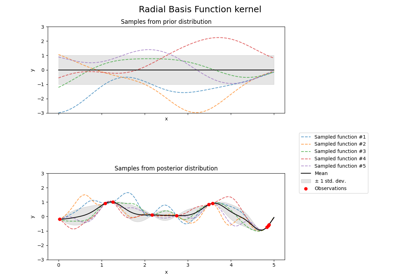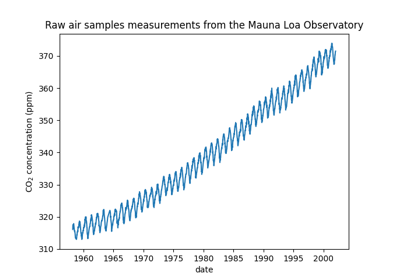ExpSineSquared#
- class sklearn.gaussian_process.kernels.ExpSineSquared(length_scale=1.0, periodicity=1.0, length_scale_bounds=(1e-05, 100000.0), periodicity_bounds=(1e-05, 100000.0))#
Exp-Sine-Squared 核(又称周期核)。
ExpSineSquared 核允许我们对完全重复自身的函数进行建模。它由一个长度尺度参数 \(l>0\) 和一个周期性参数 \(p>0\) 进行参数化。目前仅支持 \(l\) 为标量的各向同性变体。核函数定义如下:
\[k(x_i, x_j) = \text{exp}\left(- \frac{ 2\sin^2(\pi d(x_i, x_j)/p) }{ l^ 2} \right)\]其中 \(l\) 是核的长度尺度,\(p\) 是核的周期性,\(d(\cdot,\cdot)\) 是欧几里得距离。
更多信息请参阅 用户指南 。
Added in version 0.18.
- Parameters:
- length_scalefloat > 0, default=1.0
核的长度尺度。
- periodicityfloat > 0, default=1.0
核的周期性。
- length_scale_bounds一对浮点数 >= 0 或 “fixed”, default=(1e-5, 1e5)
‘length_scale’ 的下界和上界。 如果设置为 “fixed”,则在超参数调整期间 ‘length_scale’ 不能更改。
- periodicity_bounds一对浮点数 >= 0 或 “fixed”, default=(1e-5, 1e5)
‘periodicity’ 的下界和上界。 如果设置为 “fixed”,则在超参数调整期间 ‘periodicity’ 不能更改。
Examples
>>> from sklearn.datasets import make_friedman2 >>> from sklearn.gaussian_process import GaussianProcessRegressor >>> from sklearn.gaussian_process.kernels import ExpSineSquared >>> X, y = make_friedman2(n_samples=50, noise=0, random_state=0) >>> kernel = ExpSineSquared(length_scale=1, periodicity=1) >>> gpr = GaussianProcessRegressor(kernel=kernel, alpha=5, ... random_state=0).fit(X, y) >>> gpr.score(X, y) 0.0144... >>> gpr.predict(X[:2,:], return_std=True) (array([425.6..., 457.5...]), array([0.3894..., 0.3467...]))
- __call__(X, Y=None, eval_gradient=False)#
返回核函数 k(X, Y) 及其梯度(可选)。
- Parameters:
- Xndarray,形状为 (n_samples_X, n_features)
返回核函数 k(X, Y) 的左参数
- Yndarray,形状为 (n_samples_Y, n_features),默认=None
返回核函数 k(X, Y) 的右参数。如果为 None,则计算 k(X, X)。
- eval_gradientbool,默认=False
确定是否计算关于核函数超参数对数的梯度。 仅在 Y 为 None 时支持。
- Returns:
- Kndarray,形状为 (n_samples_X, n_samples_Y)
核函数 k(X, Y)
- K_gradientndarray,形状为 (n_samples_X, n_samples_X, n_dims),可选
核函数 k(X, X) 关于其超参数对数的梯度。仅在
eval_gradient为 True 时返回。
- property bounds#
返回对theta进行对数变换后的边界。
- Returns:
- boundsndarray of shape (n_dims, 2)
核函数超参数theta的对数变换边界
- clone_with_theta(theta)#
返回具有给定超参数 theta 的自身克隆。
- Parameters:
- thetandarray of shape (n_dims,)
超参数
- diag(X)#
返回核 k(X, X) 的对角线。
此方法的结果与 np.diag(self(X)) 相同;然而, 它可以更高效地进行评估,因为只评估对角线。
- Parameters:
- Xndarray of shape (n_samples_X, n_features)
返回核 k(X, Y) 的左参数
- Returns:
- K_diagndarray of shape (n_samples_X,)
核 k(X, X) 的对角线
- get_params(deep=True)#
获取此内核的参数。
- Parameters:
- deepbool, 默认=True
如果为True,将返回此估计器及其包含的作为估计器的子对象的参数。
- Returns:
- paramsdict
参数名称映射到它们的值。
- property hyperparameter_length_scale#
返回长度尺度
- property hyperparameters#
返回所有超参数规范的列表。
- is_stationary()#
返回内核是否是平稳的。
- property n_dims#
返回内核的非固定超参数的数量。
- property requires_vector_input#
返回内核是否定义在固定长度的特征向量或通用对象上。默认为True以保持向后兼容性。
- set_params(**params)#
设置此内核的参数。
该方法适用于简单内核和嵌套内核。后者具有形式为
<component>__<parameter>的参数,因此可以更新嵌套对象的每个组件。- Returns:
- self
- property theta#
返回非固定超参数的(扁平化、对数变换后的)值。
注意,theta通常是内核超参数的对数变换值,因为这种搜索空间的表示更适合超参数搜索,例如长度尺度等超参数自然存在于对数尺度上。
- Returns:
- thetandarray of shape (n_dims,)
内核的非固定、对数变换后的超参数




